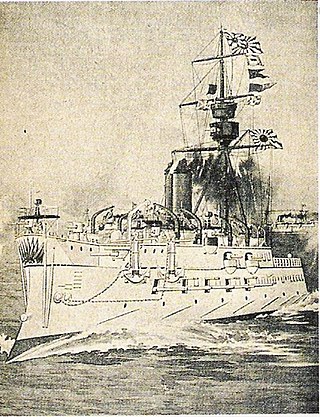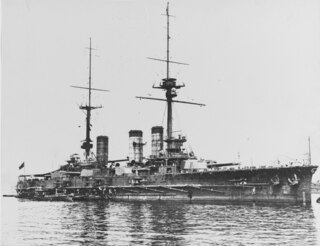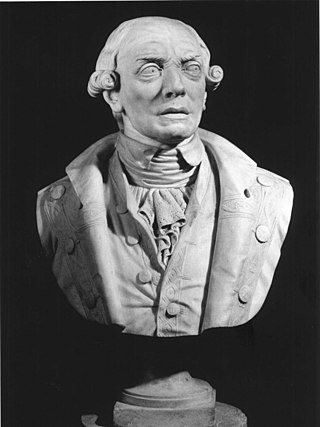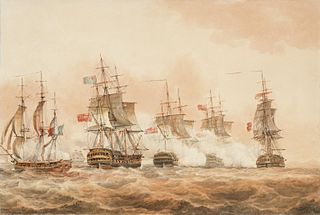
The "seventy-four" was a type of two-decked sailing ship of the line, which nominally carried 74 guns. It was developed by the French navy in the 1740s, replacing earlier classes of 60- and 62-gun ships, as a larger complement to the recently-developed 64-gun ships. Impressed with the performance of several captured French seventy-fours, the British Royal Navy quickly adopted similar designs, classing them as third rates. The type then spread to the Spanish, Dutch, Danish and Russian navies.

The Venetian Arsenal is a complex of former shipyards and armories clustered together in the city of Venice in northern Italy. Owned by the state, the Arsenal was responsible for the bulk of the Venetian Republic's naval power from the Late Middle Ages to the early modern period. It was "one of the earliest large-scale industrial enterprises in history".

Matsushima was a Matsushima-class protected cruiser of the Imperial Japanese Navy. Like her sister ships, her name comes from one of the traditional Three Views of Japan, in this case, the Matsushima archipelago near Sendai in Miyagi prefecture.

Hashidate was the third in the Matsushima class of protected cruisers in the Imperial Japanese Navy. The ship was the only one of the class constructed in Japan. Like sister ships, her name comes from one of the traditional Three Views of Japan, in this case, the Ama-no-hashidate in northern Kyoto prefecture on the Sea of Japan.

Satsuma (薩摩) was a semi-dreadnought battleship built for the Imperial Japanese Navy (IJN) in the first decade of the 20th century. Lead ship of her class, she was the first battleship built in Japan. She was named for Satsuma Province, now a part of Kagoshima prefecture. The ship saw no combat during World War I, although she led a squadron that occupied several German colonies in the Pacific Ocean in 1914. Satsuma was disarmed and sunk as a target in 1922–1924 in accordance with the terms of the Washington Naval Treaty of 1922.

Fusō (扶桑) was a central-battery ironclad built for the Imperial Japanese Navy (IJN) in the 1870s. She was built in the United Kingdom because such ships could not yet be constructed in Japan. The ship participated in the First Sino-Japanese War of 1894–95 where she was damaged during the Battle of the Yalu River in 1894 and participated in the Battle of Weihaiwei in early 1895. She collided with two Japanese ships during a storm and sank in 1897. She was refloated the following year and repaired. Fusō played a minor role in the Russo-Japanese War of 1904–1905 and was reclassified as a coast defense ship after the war. She was struck from the Navy List in 1908 and sold for scrap the following year.

Aki (安芸) was one of two Satsuma-class semi-dreadnought battleship built for the Imperial Japanese Navy (IJN) during the first decade of the 20th century. She was the second battleship built domestically in Japan and the first to use steam turbines for propulsion. The ship was named for Aki Province, now a part of Hiroshima Prefecture. The ship saw no combat during World War I. Aki was disarmed in 1922 and sunk as a target in 1924 in accordance with the terms of the Washington Naval Treaty of 1922.

Angelo Emo was a Venetian noble, administrator, and admiral. He is notable for his reforms of the Venetian navy and his naval campaigns, being regarded as the last great admiral of the Venetian Republic.

The three Chikuma-class cruisers were protected cruisers operated by the Imperial Japanese Navy. They participated in numerous actions during World War I.

The two Suma-class cruisers were protected cruisers operated by the Imperial Japanese Navy. While more lightly armed and armored than many of its contemporaries, their small size and relatively simple design facilitated their construction and their relatively high speed made them useful for many military operations. Both participated in combat during the Russo-Japanese War and World War I.

The Ordnance QF Hotchkiss 6 pounder gun Mk I and Mk II or QF 6 pounder 8 cwt were a family of long-lived light 57 mm naval guns introduced in 1885 to defend against new, small and fast vessels such as torpedo boats and later submarines. There were many variants produced, often under license which ranged in length from 40 to 58 calibers, but 40 caliber was the most common version.

The QF 3-pounder Hotchkiss or in French use Canon Hotchkiss à tir rapide de 47 mm were a family of long-lived light 47 mm naval guns introduced in 1886 to defend against new, small and fast vessels such as torpedo boats and later submarines. There were many variants produced, often under license which ranged in length from 32 to 50 calibers but 40 caliber was the most common version. They were widely used by the navies of a number of nations and often used by both sides in a conflict. They were also used ashore as coastal defense guns and later as an anti-aircraft gun, whether on improvised or specialized HA/LA mounts.

The Battle of Lissa, also known as the Battle of Vis was a naval action fought between a British frigate squadron and a much larger squadron of French and Italian frigates and smaller vessels on Wednesday, 13 March on 1811 during the Adriatic campaign of the Napoleonic Wars. The engagement was fought in the Adriatic Sea for possession of the strategically important Croatian island of Vis, from which the British squadron had been disrupting French shipping in the Adriatic. The French needed to control the Adriatic to supply a growing army in the Illyrian Provinces, and consequently dispatched an invasion force in March 1811 consisting of six frigates, numerous smaller craft and a battalion of Italian soldiers.

Corona was a 40-gun Pallas-class frigate of the Italian Navy. The French built her in Venice in 1807 for the Napoleonic Kingdom of Italy. The British captured Corona at the Battle of Lissa and took her into the Royal Navy as HMS Daedalus. She grounded and sank off Ceylon in 1813 while escorting a convoy.
KonteradmiralNicolò Pasqualigo was an Italian naval officer and nobleman who fought during the Napoleonic Wars and successively served in the navies of the Republic of Venice, the Kingdom of Italy and the Austrian Empire.

The Leon Trionfante class were a class of at least fourteen 70-gun third-rate ships of the line built by the Venetian Arsenale from 1716 to 1785, in four different series with minor changes in the ships' length. In 1797, when Venice fell to the French, Napoleon captured several ships of the class, still unfinished in the Arsenal: he chose one of them, forced the shipbuilders to have it completed and added it to his fleet en route for Egypt. After Campoformio, the remaining vessels were destroyed by the French to avoid their capture by the Austrian Empire.
The San Carlo Borromeo-class ships of the line were a class of two 66-gun third rates built by the Venetian Arsenal from 1750 to 1793.
The San Lorenzo Zustinian class were a class of at least twenty-nine 70-gun third-rate ships of the line built by the Venetian Arsenale from 1691 to 1746, in three different series with minor changes in the ships' length. It was the most numerous class of ship of the line built in Venice, and the last to see active service in a war against the Ottoman Empire in 1718. All this class' ships were planned before 1720, and the vast majority was launched before the Peace of Passarowitz. The last four vessels were completed to 70% in 1720s, then stored in the roofed shipbuilding docks of the Arsenale to be finished and launched between 1739 and 1746, a solution that was widely used with the following Leon Trionfante class.
San Vincenzo was a large frigate of the Venetian navy. Ordered in 1720 and laid down in 1722 at the Arsenal of Venice, it belonged to the Sant'Andrea class. It entered service in 1730, and was lost due to fire while undergoing repairs at the anchorage at Govino Bay in Corfu, on the night of 11 May 1752. With about 1,500 tons in total displacement, it could be equipped either as a large frigate or as a second-rank ship of the line.














